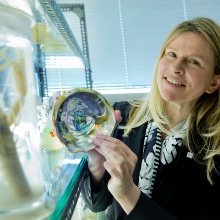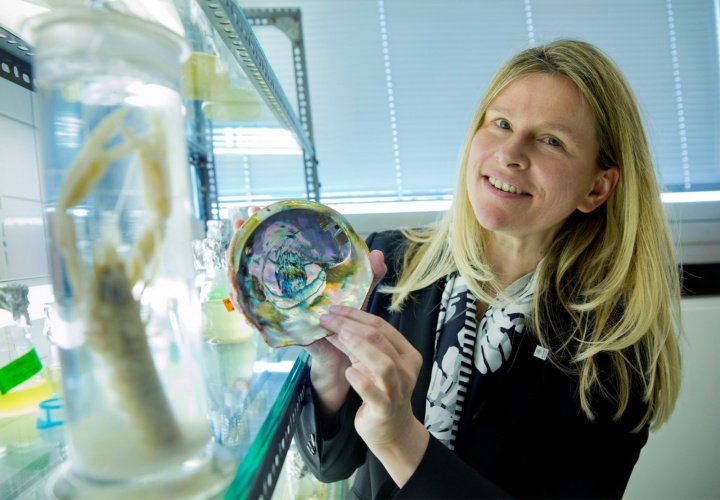Professor Ingrid Weiß took over the management of the Bio-Based Materials Department at the Institute for Biomaterials and Biomolecule Systems at the Faculty of Energy, Process Engineering and Biotechnology in the middle of 2016 and there concerns herself with system processes on the boundaries between biology and materials sciences. The biologist did her PhD in Regensburg and most recently did research work at the Leibniz Institute for New Materials in Saarbrücken. She was particularly inspired at the University of Stuttgart by the diverse range of possibilities for cooperations and the important investments in the infrastructure.
Nature is superior to artificial production in many ways
In forming biomaterials, such as claws, fingernails, seashells, feathers or insect wings, organisms resp. their cells position each molecule, each atom in the right place. Up to now no machine has been in a position to achieve this high degree of order in production, let alone under normal environmental conditions as the organisms do, but only under extreme conditions such a high pressure or temperature. “Nature succeeds in producing solid, functional materials from a soft, almost liquid-like cake glaze-like tissue such as oysters“, is how Ingrid Weiß explained this fascinating process. Also the diversity and the functionality of the materials created by nature are unparalleled to date. The organisms are able to produce very firm and solid or wafer thin structures. The materials often display great strength and are in spite of this flexible and are not easily breakable.
First evidence of a motor protein succeeded
The 46-year-old cultivates her research material high up on the 10th floor of NWZ II (Pfaffenwaldring 57): oysters and common mussels. “As soon as two days after fertilization the embryos begin to form polymers“, she reported. How this works, how the cell knows, what is to be done when: she wants to discover this secret. She has already succeeded in the initial step. She is the first person worldwide to be able to prove that the mussel species Atrina rigida has a motor protein that acts as a “material sensor”. This sensor “recognizes” when enough material is on hand, when the formation of a new polymer layer is to start and when the bio-mineralization should commence. In the meantime this type of sensor could be shown in three different species of mussels.
Communication between cell and material
Professor Weiß is confident that the cells possess a molecular machine, a synthesis apparatus that knows how biopolymers are produced and joined together. The fact that this apparatus exists and how it works is something the biologist would like to prove and decipher: “By adding certain materials we are able to disturb the cells.“ Then the building plans are no longer performed error-free but cracks appear in the shells, the size ratios no longer fit, the material becomes breakable, etc. “All this indicates that there are regulating mechanisms behind the development processes of the biomaterials. There must be communication between cell and material ensuring the perfect formation of the biomaterials“, is something Professor Weiß is convinced of.
Excellent cooperation opportunities
The cooperation with various special fields of is great important for her research work. “In view of cooperation opportunities the University of Stuttgart is a paradise for me“, enthuses Ingrid Weiß, “I will never find a comparable environment like here anywhere in the world in our specialist area.“ It starts with the colleagues in our own institute and in our own faculty. In addition there are close cross-links from biology to the specialist fields of physics, chemistry and medicine and process engineering as well as bioinformatics and HLRS. There are also overlaps with Faculty 7 Construction, Production and Automotive Engineering and Architecture. It is important to bring together scientists working experimentally with scientists working theoretically and “with our findings on the fundamentals of biology we can build a bridge to the applications“. Moreover, the boundary crosser between biology and materials sciences likes the fact that she will be able to give the students in Stuttgart an understanding of the complexity of research in her faculty with the course Technical Biology from the very first semester onwards.
New centre for electron microscopy
Many joint cooperations are being planned with Professor Stefan Weihe, the Director of the Material Testing Institute (MPA). “We are in the same faculty but span a very wide area with our cooperation.“ An electron microscopy centre is being established at the MPA, the funds for this were released in the course of Ingrid Weiß´s appointment.
Know-how is already many millions of years old
The professor from Bavaria really likes Stuttgart and its surroundings. When she isn’t working she like riding a motorbike. The Swabian Mountains and the Alps that she crosses on her way home reminds her with her diverse number of fossils that organisms that had the know-how to produce biomaterials already existed millions of years ago. Even as a child she collected snails and wanted her own microscope, the professor recalls. Since then she has never lost her enthusiasm and fascination, something you notice immediately when Ingrid Weiß talks about her research work.



